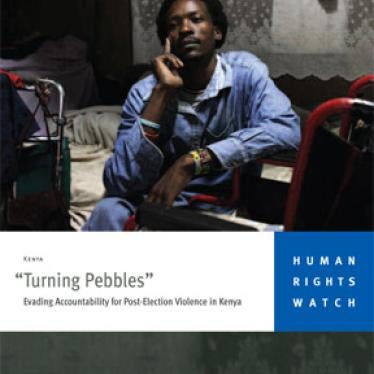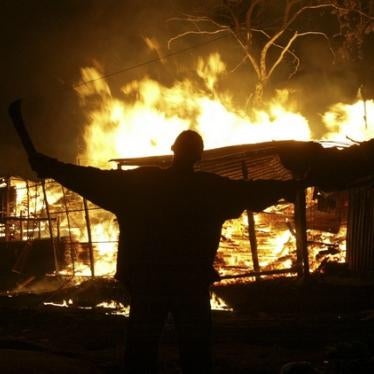(Nairobi) – The Kenyan authorities should promptly investigate and prosecute those responsible for shootings by the police in Kisumu on March 30, 2013. Five people died and at least twenty-four were injured.
The shootings occurred in the wake of demonstrations against the Kenyan Supreme Court ruling on March 30 upholding President Uhuru Kenyatta’s election victory on March 4. Human Rights Watch interviewed witnesses, civil society leaders, and government officials about the violence.
“Not only did the police open fire on protesters in Kisumu on March 30, but it seems they tried to conceal the evidence and intimidate the victims,”said Leslie Lefkow, deputy Africa director.“It looks like the Kisumu police tragically haven’t learned any lessons from the last time they opened fire on protesters.”
During the violence that followed the 2007 presidential election, police used live ammunition unnecessarily against scores of protestors in Kisumu, killing 115 people. The killings were never adequately investigated or prosecuted.
Human Rights Watch research indicates that on March 30 the police used live ammunition when trying to control crowds in Kisumu, including groups that were not part of the riots, killing at least five people by that evening.
While some media reports have suggested the number of injured could be higher than 24, the exact number was difficult to establish because people were afraid to come forward. Human Rights Watch heard from multiple credible sources, including people who were shot and injured, family members of victims, and members of civil society, that fear of police reprisals prevented some people from seeking medical treatment at the hospital or even taking the bodies of their dead relatives to the mortuary.
Kisumu, the capital until 2012 of what was Nyanza province in western Kenya, was under heavy security leading up to the March 4 elections and the Supreme Court decision. Kisumu county is considered a stronghold of former Prime Minister Raila Odinga, Kenyatta’s closest competitor for the presidency. Tensions increased in Kisumu in the period leading up to the court ruling and some youth supporters of Odinga reacted violently to the Supreme Court judgment.
Kisumu’s Kondele and the neighboring Nyawita settlement areas were the epicenter of unrest after the court decision. Demonstrators barricaded roads, burned tires, and looted shops. Witnesses told Human Rights Watch that police simultaneously used rubber bullets, teargas, and live bullets. They also kicked, slapped, and whipped with sticks and batons anyone who crossed their path, irrespective of whether they were participating in violence.
At around 6 p.m., witnesses told Human Rights Watch, police shot into the crowd in Kondele, killing Joseph Ongor, outside the Lake Breeze Hotel. The killing appeared to escalate the tensions and demonstrators began throwing stones at the police.
Witnesses said that, just moments later, police shot a 27-year-old male passenger on a motorcycle taxi at the Kondele overpass on his way home. He died that night in Jaramogi Oginga Odinga Teaching and Referral Hospital. Police told Human Rights Watch that a man was killed at Kondele overpass during riots but said it was not clear whether the police were responsible.
Witnesses told Human Rights Watch that demonstrators in Nyawita also barricaded roads and burned tires, but witnesses and local civil society officials said that the protesters dispersed after police shot a woman who was washing utensils outside her house, killing her instantly.
Tension began in the early morning of March 30 at Kibuye market, along the road to Kakamega, with people congregating in small groups to discuss the expected court decision, and then later the decision itself. But the crowds in the market area did not become violent, witnesses said, and dispersed after an order by police traveling in a truck from the town center to the riot area in Kondele.
However, police who got out of the truck around Kibuye market that evening shot and killed two other people, witnesses told Human Rights Watch. They said the police started firing teargas to disperse people but also fired live bullets into groups of people. The police shot and killed a woman who was selling second-hand clothes in the market and they shot a carpenter in the back as he was closing down his shop. Police told Human Rights Watch that they were only aware of the death of the carpenter, for which they said police have not taken responsibility because the killing was still being investigated.
All evidence indicates police used excessive force in violation of Kenyan and international law. All killings and injuries should be investigated immediately and those responsible held to account.
Kenyan security forces should abide by the United Nations Basic Principles on the Use of Force and Firearms by Law Enforcement Officials. The principles call upon law enforcement officials to apply nonviolent means and to use force only when strictly unavoidable to protect life. The principles also require governments to ensure that arbitrary or abusive use of force and firearms by law enforcement officials is punished as a criminal offense under their law.
A Kenya Red Cross volunteer told Human Rights Watch that, by 9 p.m. on March 30, he had counted 14 patients with gunshot wounds at the Jaramogi Hospital. Patients continued to arrive throughout the night, although the hospital authorities, citing fear of possible reprisals from police, declined to confirm the exact number admitted. At least three other people with gunshot wounds were admitted to Kisumu District Hospital. A civil society organization in Kisumu said it assisted another three people in Ahero and four in Homa Bay who had gunshot wounds and were not admitted to either of the two hospitals.
Relatives of victims and human rights defenders in Kisumu said that anyone who went to hospital with gunshot wounds that evening was arrested by police, scaring away some of the injured who might otherwise have sought medical treatment.
Witnesses and local activists told Human Rights Watch that police tried to conceal evidence of the shootings by confiscating the bullets from the wounded and threatening injured patients with arrest. Credible sources told Human Rights Watch that police cleared up bullets from the streets and tried to force hospital staff to hand over the bullets removed from shooting victims.
The National Police Service Commission should independently investigate the conduct of police in Kisumu, especially in the face of indications that police used excessive force.
“The arrest and intimidation of patients and medical staff raises serious questions about police conduct in responding to the civil unrest in Kisumu,” Lefkow said. “Police efforts to confiscate bullets and deny the real number of deaths and injured people suggests a cover-up.”
Police Shooting Victims Describe Hospital Arrests, Cover-Up, Intimidation
A man who was shot in the abdomen in Kondele while seeking to buy timber told Human Rights Watch that he escaped the hospital after he heard the police pressuring medical staff to turn over bullets retrieved from the wounded.
“I could hear police demanding the bullets from the doctors, who were reluctant to give them,” he said. “I sneaked out of the hospital when I suspected police were going to arrest me. Later I heard that all those who were found with bullet wounds were arrested from the hospital that night.” The man is now in hiding and has not been able to access medical treatment for fear that he will be arrested.
Another victim told Human Rights Watch that while he waited for three days at Jaramogi Hospital for an operation to remove a bullet from his head, police pressed medical staff to hand the bullet over to them once it was removed, but that doctors were reluctant to do so. When a Kisumu politician visited the hospital and demanded the bullet as proof of police brutality, police ordered the transfer of the patient to another hospital, almost 200 kilometers from Kisumu, and placed the victim under heavy security for two weeks in the new hospital, pending the removal of the bullet.
Police also arrested some people with gunshot wounds and removed them from the hospital. Together with those who were arrested in a police operation in the town two days after the riots, they were charged in a Maseno Magistrate’s court, 30 kilometers from Kisumu, with “robbery with violence.” Credible sources told Human Rights Watch that 43 people were charged this way, but just two have been able to raise the hefty bonds of up to one million Kenyan shillings (US$12,000) for their release.
One of those arrested at the hospital and charged with “robbery with violence” was a man whose name was given only as Mr. Otanda, who had not participated in the demonstrations, but was shot and admitted to the hospital just before midnight on March 30. He was arrested at the hospital the next day. “They did not even give him time to heal and yet he was not even part of the riot,” said a civil society official. He is still being held at Kodiaga Prison because he could not raise a one million shilling bond.
The Police Response
The exact number of those killed is not clear. Human Rights Watch research indicates that five people died from police shooting, but provincial police officials told Human Rights Watch that there were only two deaths: the 27-year-old man at the Kondele Flyover and the carpenter in Kibuye market.
In an interview with Human Rights Watch, the police commander who was in charge of police in Kondele area on March 30 said, “These are the only two people who died and police headquarters have instituted investigations into the cause of death. We are not aware of anyone who suffered gun injuries because no one has reported to us. We cannot investigate gun injuries unless someone has reported a case.”
A senior Criminal Investigations Officer in Nyanza region also insisted that just two people had died and that no one had gun injuries: “Police are investigating two deaths which occurred during the riots. We have opened two files. We do not know whether it is the police who shot them or someone else who did it. We cannot say there were people with gun injuries because we have not received any reports.”
Kisumu residents and some members of civil society organizations say that police had a “shoot to kill” order. “The boys in Kondele said they overheard police say they were going to shoot a few just to teach people in Kisumu a lesson,” one human rights activist in Kisumu told Human Rights Watch. A youth in Kisumu said police shouted at them: “We forgave you people in Kisumu during the 2007-2008 violence. This time we are going to teach you a lesson.”
Police have denied the allegation but concede that some police officers were armed with live bullets. The officer who commanded police during the riots in Kondele told Human Rights Watch: “The police were in riot gear and had guns for firing rubber bullets and blanks. But during riots we have an armed party. The armed party usually has live bullets. You cannot go to a riot situation with just rubber bullets and you are facing very dangerous groups. Live bullets can be used.”
But evidence suggests that, despite denials to Human Rights Watch, the police were aware that scores of people had sustained gun injuries in the violence. A senior official at the Jaramogi Hospital told Human Rights Watch that police later wrote to the hospital to ask for a full list of those who had been admitted there with gunshot wounds and injuries from police beatings following the riots and the hospital complied.








